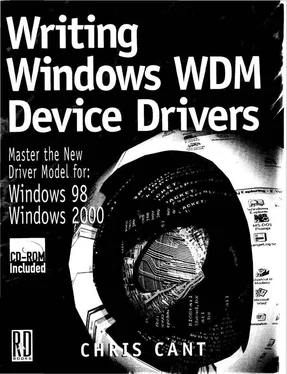Chris Cant - Writing Windows WDM Device Drivers
Здесь есть возможность читать онлайн «Chris Cant - Writing Windows WDM Device Drivers» весь текст электронной книги совершенно бесплатно (целиком полную версию без сокращений). В некоторых случаях можно слушать аудио, скачать через торрент в формате fb2 и присутствует краткое содержание. Город: Lawrence, Kansas 66046, ISBN: , Издательство: R & D Books, Жанр: Программирование, на английском языке. Описание произведения, (предисловие) а так же отзывы посетителей доступны на портале библиотеки ЛибКат.
- Название:Writing Windows WDM Device Drivers
- Автор:
- Издательство:R & D Books
- Жанр:
- Год:неизвестен
- Город:Lawrence, Kansas 66046
- ISBN:0-87930-565-7
- Рейтинг книги:5 / 5. Голосов: 1
-
Избранное:Добавить в избранное
- Отзывы:
-
Ваша оценка:
- 100
- 1
- 2
- 3
- 4
- 5
Writing Windows WDM Device Drivers: краткое содержание, описание и аннотация
Предлагаем к чтению аннотацию, описание, краткое содержание или предисловие (зависит от того, что написал сам автор книги «Writing Windows WDM Device Drivers»). Если вы не нашли необходимую информацию о книге — напишите в комментариях, мы постараемся отыскать её.
Writing Windows WDM Device Drivers — читать онлайн бесплатно полную книгу (весь текст) целиком
Ниже представлен текст книги, разбитый по страницам. Система сохранения места последней прочитанной страницы, позволяет с удобством читать онлайн бесплатно книгу «Writing Windows WDM Device Drivers», без необходимости каждый раз заново искать на чём Вы остановились. Поставьте закладку, и сможете в любой момент перейти на страницу, на которой закончили чтение.
Интервал:
Закладка:
It is particularly important that you document your driver well and provide ample comments in your code. Device drivers are complicated enough at the best of times. Having to look at someone else's code without any explanation of what is going on can be difficult.
Your hardware and firmware engineering colleagues should have provided you with a suitable interface specification for the device you have to control. You will bring these requirements together with the specification of any bus or class drivers you intend to use. At the end of the day you will have specified your driver's lower edge — the hardware and software interactions that you use to get your job done.
Similarly, you should define your upper edge. This is the interface that your driver presents to user mode applications or higher-level drivers. You need to define what devices you make available and which Win32 functions can be used to access the devices. Specify the parameters in detail and the contents of all buffers. Give your Win32 colleagues a suitable header file.
Whatever your approach, a good design needs to be configurable, portable, preemptive, interruptible, and multiprocessor-safe.
A driver should be as configurable as possible — at least as configurable as the hardware allows. A device on a configurable bus ought to have a Plug and Play driver. Use the registry and the control panel to control how a driver runs.
Making a driver portable between platforms is usually fairly straightforward. Drivers should be easily recompiled to support non-x86 processors. WDM drivers need to run on W98 and W2000. Make sure that you only use routines that are available on both platforms. Write the driver in C or C++ and avoid using assembly language. Use the appropriate kernel routines to access hardware. Beware of data types that have different sizes on different processors. Other processors may have different virtual memory page sizes.
When your driver is running at a low interrupt level (see the following text), the operating system may perform a context switch at any time. Remember that higher priority interrupts can occur at any time, so your driver must bear this in mind. Even your ISR can be interrupted.
In an NT/W2000 multiprocessor system, your driver could be called simultaneously on different processors, so the code needs to be reentrant. As NT/W2000 supports symmetric multiprocessing, an interrupt may be handled on any processor. Even on a single processor system, your code needs to be reentrant. Your code could block while processing one IRP, or a context switch could occur. This could allow another IRP to start processing before the first IRP has completed.
Various techniques and routines are used to handle interrupts and multiprocessor systems. For example, critical sections ensure that a device operation is not interrupted. Spin lock tokens can guard access to work queues. Various dispatcher objects (events, Mutexes, semaphores, timers, and threads) can be used to signal conditions and synchronize with the other parts of your driver.
The kernel also provides mechanisms to arbitrate access to shared hardware devices such as the system DMA controllers. In NT7W2000, if your own hardware has a controller that is shared between devices, use the Controller object to arbitrate access, rather than rolling your own.
Look to see if the kernel already provides you with a feature (e.g., string manipulation facilities and management of a pool of memory blocks). These facilities are discussed as appropriate throughout the book.
A good driver checks each and every return value from any routines that it uses (e.g., in the kernel or other drivers). If an error occurs, make sure you rollback your transaction correctly before returning the error.
The layered device driver design
By now you will, of course, be writing Y2K-compliant code. However, this problem may not occur all that often in drivers. If appropriate, your driver should include accessibility options for people who have difficulty performing certain tasks. Bear in mind that many of your users may not use English as their first language, so internationalize as necessary. For example, provide different language event messages. Note that the strings that drivers must use are in Unicode.
Finally, it is best if you follow the driver routine naming conventions described later. Document and test your work as you go along. At the end, go through all the comments and make sure they are up to date.
Kernel Calls
Device drivers cannot access any standard C, C++, or Win32 functions. You cannot use the C++ new and delete operators. Instead, you must make use of a large number of kernel routines. The main categories of kernel routines are shown in Table 3.1.
The book describes each kernel routine when it is first used. However, I decided not to provide a full list of each function's parameters because it would take up too much room. You may find it useful to have the Driver Development Kit (DDK) documentation to hand. However, I hope that you can follow the thread of the argument without having to sit beside your computer.
If you are using one of the proprietary toolkits listed in Chapter 1, these will provide a set of classes that make drivers easier to write. This includes routines that make it easier to call the kernel. For example, drivers must use Unicode strings when talking to the rest of the kernel. The kernel routines that manipulate Unicode strings are fairly laborious to use. Most proprietary toolkits provide a class wrapper for Unicode strings that makes them easier to use.
There are various Win32 function calls that are used only in connection with device drivers. In particular, the SetupDi… routines are used to find devices that implement a specified device interface.
Table 3.1 Kernel Mode Routines available to drivers
Ex… |
Executive Support |
Hal… |
Hardware Abstraction Layer (NT/W2000 only) |
Io… |
I/O Manager (including Plug and Play routines) |
Ke… |
Kernel |
Ks… |
Kernel stream IRP management routines |
Mm… |
Memory Manager |
Ob… |
Object Manager |
Po… |
Power Management |
Ps… |
Process Structure |
Rtl… |
Runtime Library |
Se… |
Security Reference Monitor |
Zw… |
Other Routines |
Table 3.2 shows routines that are used only by specific types of driver. Most of these are provided for miniclass drivers, miniport drivers, and minidrivers. Others, such as the Hid… and Usb… functions are used by client drivers.
In addition to those routines listed, audio miniport drivers define several standard interfaces. The IEEE 1394 bus driver makes many routines available, with no common initial name.
Table 3.2 Bus driver and class specific routines
BatteryClass… |
Battery class routines for miniclass drivers |
Hid… |
Human Input Device routines |
Pc… |
Port class driver routines |
ScsiPort… |
SCSI port driver routines for miniport drivers |
StreamClass… |
Stream class driver functions for stream minidrivers |
TapeClass… |
SCSI Tape class routines for miniclass drivers |
Usb… |
Universal Serial Bus Driver Interface routines for USB client drivers |
If you look in the DDK header files, you will find that a few of the kernel functions are implemented as macros. The definition of one or two of these macros is quite poor. For example, RemoveHeadList is defined as follows:
Читать дальшеИнтервал:
Закладка:
Похожие книги на «Writing Windows WDM Device Drivers»
Представляем Вашему вниманию похожие книги на «Writing Windows WDM Device Drivers» списком для выбора. Мы отобрали схожую по названию и смыслу литературу в надежде предоставить читателям больше вариантов отыскать новые, интересные, ещё непрочитанные произведения.
Обсуждение, отзывы о книге «Writing Windows WDM Device Drivers» и просто собственные мнения читателей. Оставьте ваши комментарии, напишите, что Вы думаете о произведении, его смысле или главных героях. Укажите что конкретно понравилось, а что нет, и почему Вы так считаете.






